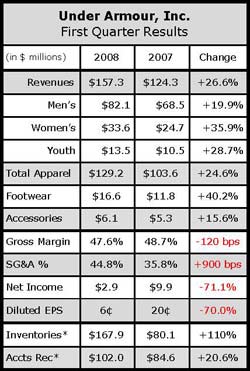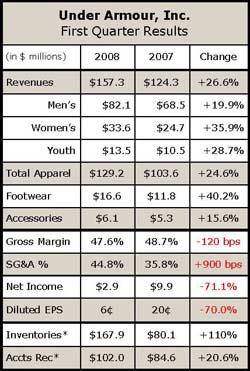Under Armour Inc. posted another solid quarter for sales growth, but a sharp increase in marketing expenses and tighter margins cut into profits as net income plunged more than 71% compared to the year-ago period. The company is still struggling with the inventory overhang that started in the third quarter last year as it ramped up for a fall/winter business that came too late in the season to clear the decks. That issue, exacerbated by excessive inventory of unsold gloves, has cut into cash reserves that have declined nearly 70% since the end of the year-ago first quarter and may be a factor in the companys decision to expand on its plan to ramp up outlet stores.
for sales growth, but a sharp increase in marketing expenses and tighter margins cut into profits as net income plunged more than 71% compared to the year-ago period. The company is still struggling with the inventory overhang that started in the third quarter last year as it ramped up for a fall/winter business that came too late in the season to clear the decks. That issue, exacerbated by excessive inventory of unsold gloves, has cut into cash reserves that have declined nearly 70% since the end of the year-ago first quarter and may be a factor in the companys decision to expand on its plan to ramp up outlet stores.
Still, the Under Armour brand continues to take share and has maintained the top market share position in Sport Apparel in the full-line sporting goods channel for the second straight quarter, according to retail point-of-sale data compiled by SportScanINFO, after knocking Nike from that position in the fourth quarter. The company has clearly moved beyond its former position as a compression apparel brand for guys as loose-fitting product, outerwear and womens product all posted stronger growth. The brand has hopes of improving share further by broadening distribution in the athletic specialty channel as test programs at Finish Line are expanded and new programs at Foot Locker kick in this spring.
However, the companys fortunes will perhaps be assessed by Wall Street based on the success of the much-anticipated performance trainer launch this last weekend. Of the million pairs of footwear it expects to sell this year, Under Armour expects 60% will ship in the second quarter to cover the launch and then a color up for July 1. There is another delivery date for second generation product that is scheduled for November.
The inventory position, excluding roughly $13.6 million in footwear brought in early, was up approximately 93% at the end of the quarter compared to the year-ago period.
Management expects the year-over-year inventory growth rate to decelerate as the year progresses, beginning with the second quarter. By the end of the third quarter they expect inventory growth to be in line with sales growth, and by the end of the fourth quarter, they are projecting inventory to grow at a rate below the annual sales growth for 2008, or growth of 26% to 28% for the year. Much of the improvement will come from the sell-down of core basic product as they move into the third quarter and push more of the seasonal product through their outlet stores.
To facilitate a more timely liquidation of the seasonal inventory, the company has lowered its target gross margin so the outlet stores can move goods through at a faster rate, a move that is expected to have an impact on the full-year margin rate. Additionally, Under Armour is now planning to open nine retail outlet stores in 2008 instead of the original plan for just five stores.
The direct-to-consumer business posted a 57% increase in website sales, which, coupled with an expanding outlet business and the addition of a single full-price store, pushed direct-to-consumer revenues up nearly 77% for the period. In addition to the expanded outlet strategy, the company also sees testing at least two additional full-price retail stores this year.
The gross margin lift from the increase in direct-to-consumer revenues was offset by the margin impact of footwear sold during the period as the first wave of performance trainers were shipped out to retail.
Still, gross margins took a hit in Q1, down 120 basis points to 47.6% of sales, as UA increased inventory reserves, primarily on the excess glove inventories.
The other major impact on the bottom line came from the increased marketing spend to support the performance trainer launch as UA boosted marketing expenses to 17.8% of revenues in Q1, compared to 11.1% of revenues in the year-ago period.
Looking ahead, Under Armour continues to see full year revenue growth in the 26% to 28% range, or a range of $765 million to $775 million. Margins are expected to be down 30 basis points for the year to approximately 50% as any gross margin impact from the increase in footwear is expected to be largely offset by the growth in the direct-to-consumer business. The company had previously expected a 40 to 50 basis point improvement in gross margins for the year. UA also cut its outlook for income from operations for the year to a range of $103.5 million to $104.5 million, compared to previous estimates of income from operations in the range of $108.5 million to $110.5 million.
















